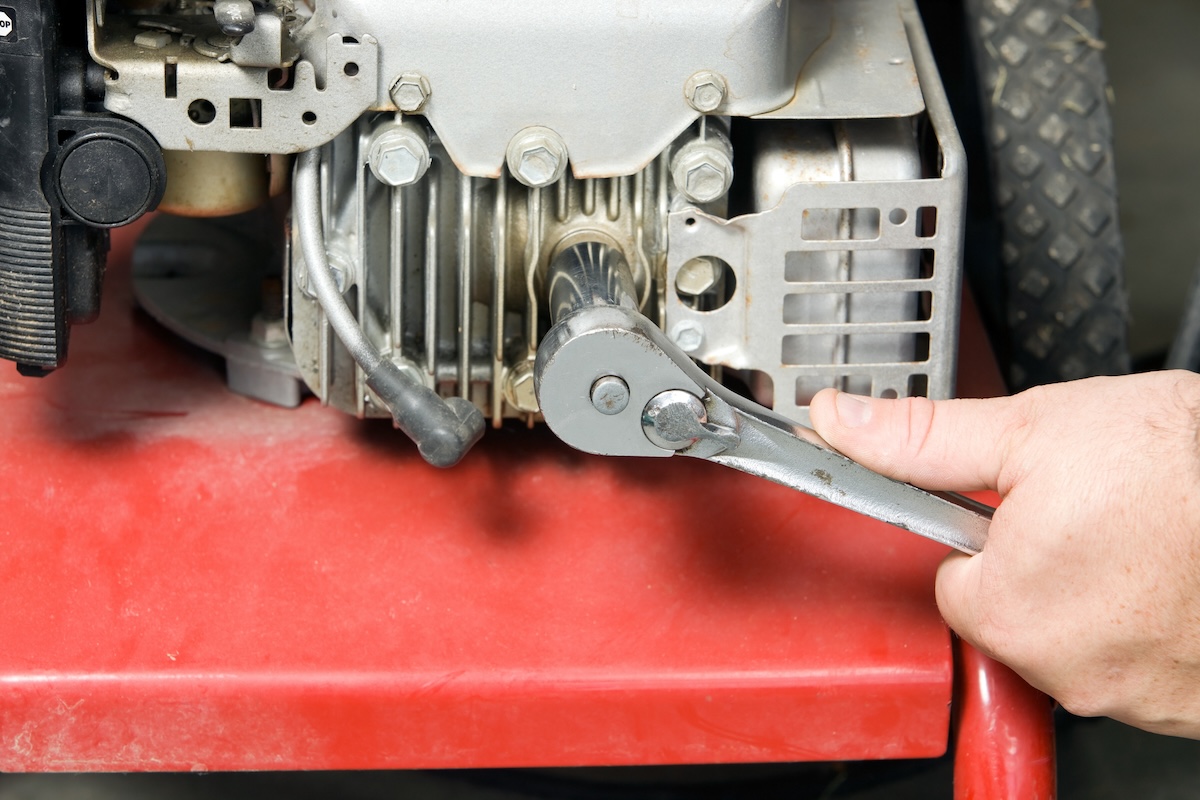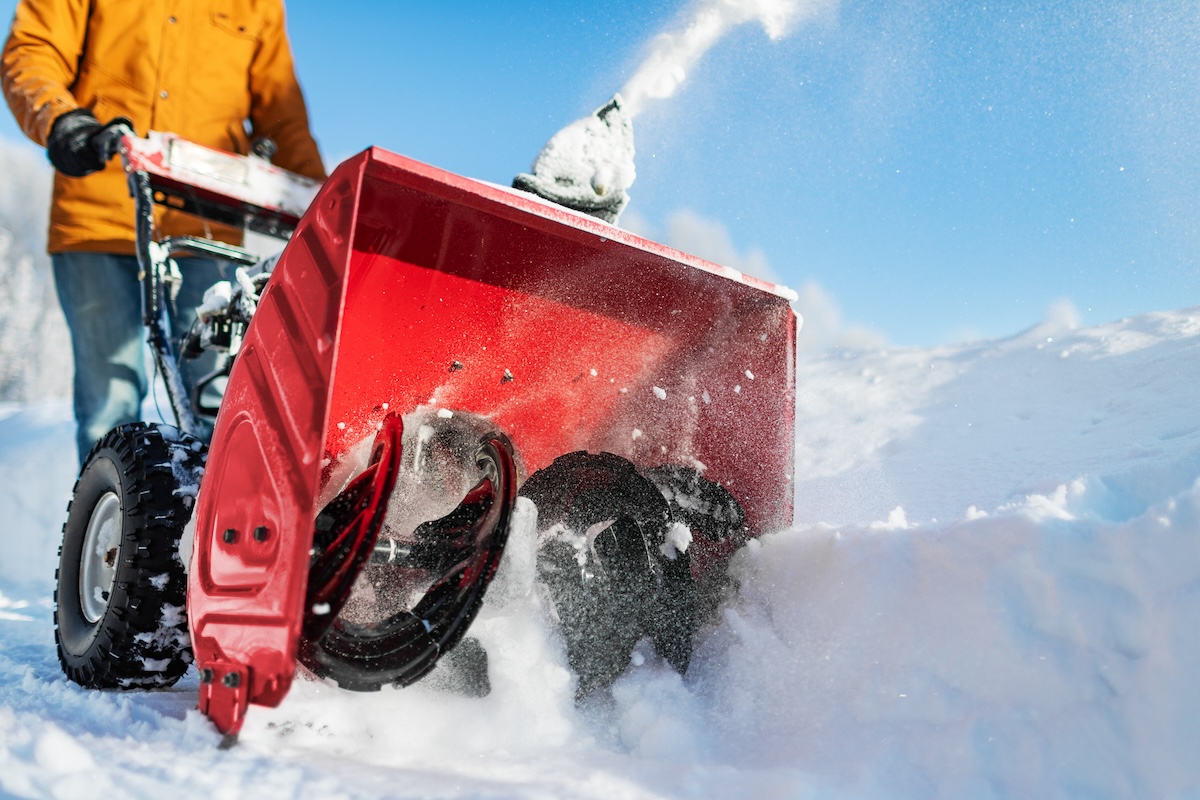

We may earn revenue from the products available on this page and participate in affiliate programs. Learn More ›
If your snow blower has gathered dust since last winter, it might not start when you need it this winter season. Like all motorized equipment, snow blowers require periodic maintenance in order to operate efficiently. Assuming yours ran well when you last used it, there’s a good chance the problem is something minor that you can fix yourself.
Before trying the tips below to fix a snow blower that won’t start, pull out your owner’s manual (or download a copy from the manufacturer’s website). While virtually all snow blowers feature the same components—valves, filters, gas tanks, carburetors, fuel lines, and switches—their configurations vary by brand, so the manual will help you locate and identify them.
“It’s good to start with the basic controls and function of the machine,” says Wes Bollingmo, Channel and Product Support Manager at Toro. “Is something moving that shouldn’t? Is something not moving that’s supposed to? Are the tires inflated to the proper psi?”
If you don’t already have them on hand, all of the required tools for the following fixes can be found in any auto-supply store.
Make sure all switches and valves are in the correct starting position.
Today’s snow blowers have many switches, buttons, and valves that must all be in the correct position for the machine to start. “Verify cables and controls are adjusted to the specifications outlined in your manufacturer’s operator manual,” Bollingmo confirms. Your manual may call for the throttle to be in the “High” position, the fuel shut-off valve in the “Open” position, the choke in the “Full” position, and the run switch set to “On.”
“One of the most common mistakes on start-up after storage is the fuel valve,” says Bollingmo. “If you are properly prepared for storage, there is a good chance the fuel valve has been shut off. Make sure it is turned to the ‘on’ position prior to use.”
Check the safety key.
Just like a car, a snow blower has a key that must be inserted and engaged in order for the blower to start. If you’re having trouble starting your snow blower, Bollingmo suggests you ask yourself, “Is the safety key installed? Is the key in the ‘on’ position?” Sometimes in the rush to get going, it’s easy to miss the simple things.
Drain and replace old gas in the tank.
If your snow blower has sat idle for months, the gas may have developed gummy residue, which can make starting the machine difficult. Siphon out the old stuff with a small siphon pump, and then dispose of the gasoline. Fill the tank with fresh gas and try starting it again.
Add fuel stabilizer to the gas tank.

Even if you’ve drained and refilled the gas tank, residue from the old gas could be clogging the carburetor. To dissolve it, you’ll need a fuel stabilizer such as STA-BIL, a gasoline treatment product that helps liquefy residue.
Add fuel stabilizer to the snow blower’s gas tank at the rate specified on the container, and then try to start the machine. Even if it doesn’t immediately start, keep cranking by pulling the starter cord repeatedly to help work fresh fuel and stabilizer through the carburetor.
If the snow blower still won’t start, wait an hour or two to allow the fuel stabilizer more time to dissolve residue, and then try again.
Prime the engine to force fuel into the carburetor.
Gas engines are often slower to start in cold weather, so your next move is to give it a little boost of fuel. First, prime the engine by pressing the flexible primer bulb, a small rubber or silicone bulb located on your snow blower near the carburetor, three to five times. This will force a small amount of fuel into the carburetor, where it can more easily ignite.
Immediately after priming, try to start the blower. If it hasn’t been operated for months, it could take three or four attempts before it kicks on.
Check the oil.
Check the oil next, advises Bollingmo. Ensure the snow blower is on a level surface, and then locate the oil dipstick. Remove it, wipe it clean, reinsert it completely, and then pull it out again. Inspect the oil on the dipstick for both quality and quantity. If the blower is low on fuel, add more. If the oil is dark or burnt, it may be time to replace it.
Clean or replace the spark plugs.

Three things must be present in order for your snow blower to run correctly: fresh fuel, the proper amount of compression in the engine, and a spark to ignite the fuel. To satisfy the third requirement, your lawn mower’s spark plugs must be in working order. If your machine refuses to start up properly, try cleaning it or replacing the spark plugs. And don’t forget to reconnect the spark plug wire, Bollingmo cautions. Here’s how to clean spark plugs:
- Use a socket wrench and a spark plug socket to remove the plugs.
- Clean any built-up carbon deposits from the electrodes, located on the threaded end of the spark plugs. To do so, use a carburetor cleaner and a wire brush.
- Dry the plugs and reinsert them.
- Reconnect the spark plug wire.
If the snow blower still won’t start, the spark plugs may be beyond repair. Inspect the porcelain sleeves for cracks. If you find a crack, replace the spark plug with a new one.
Examine the fuel line for damage.
The fuel line, which runs from the gas tank to the carburetor, should be flexible and pliable. Over time, fuel lines can harden, and a brittle line is prone to leaking fuel, either from a crack or around the connections where it meets the gas tank and the carburetor. A leak can prevent fuel from reaching the carburetor and keep the snow blower from starting. If the line is hard, cracked, or kinked, replace it with a new one.
Clean the carburetor.
If none of the above strategies have gotten your snow blower running, you may need to clean the carburetor more aggressively to dissolve gunk and residue. A carburetor’s purpose is to combine air and fuel in a precise ratio for efficient combustion, so if it’s clogged with residue, it can’t do its job.
- Check your owner’s manual for instructions on how to access the carburetor, located beneath the air filter.
- Remove the air filter cover and the air filter.
- Look at the carburetor (a metal case with a cylindrical opening).
- Use a carb cleaner, a solvent that comes in an aerosol can with a straw that fits on the nozzle, to deliver a forceful shot of gunk-dissolving spray directly into the carburetor.
- Look for the air-intake valve. It’s an open cylindrical valve near where the air filter was connected to the carburetor.
- Spray the carb cleaner inside the air-intake valve (instructions on the can will specify how much to use).
- Replace the air filter and filter cover and then try to start the snow blower.
Call a service technician.

Troubleshooting beyond these steps may require dissembling the machine. “When you get to a point where you are no longer confident in performing a repair or are not sure where to start, you should consult a professional,” says Bollingmo. “The stakes are too high for an individual to make guesses when repairing. Improper repair could result in a snow blower that doesn’t work properly. This can cause costly repairs to the unit or property, and even worse, injury.”
If your snow blower is still under warranty, contact the manufacturer or the store where you bought it for instructions on how to proceed. If it’s an older machine, take it to a small engine repair shop. Alternatively, stores that sell lawn mowers, snow blowers, rototillers, and other small equipment often also offer repair and maintenance services. Having a service technician repair your snow blower could run anywhere between $75 and $300—sometimes as much as it would cost to replace it with an inexpensive new model—depending on the extent of the problem.
If repair estimates wind up on the higher end of that range and your machine has quite a few years on it, now might be the time to upgrade. Check out our tested guide to the best snow blowers for key considerations to choosing your next outdoor tool, and recommendations at all price points.
Final Thoughts
When it comes to snow blower health, Bollingmo cites Benjamin Franklin’s famous adage: “An ounce of prevention is worth a pound of cure,” and he then adds, “That stands true for outdoor power equipment storage practices.” He suggests careful snow blower maintenance at the end of each season to ensure it’s ready to go the following winter. “If your gas-powered snow blower was correctly prepared for storage,” he says, “you will be ahead of the game, and the next snowstorm!”
